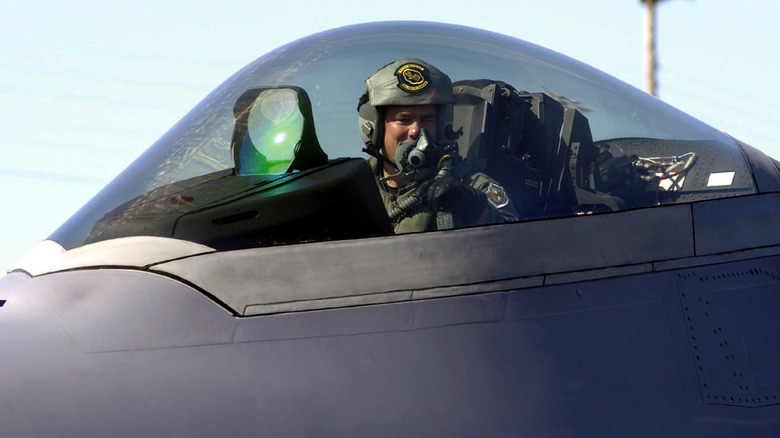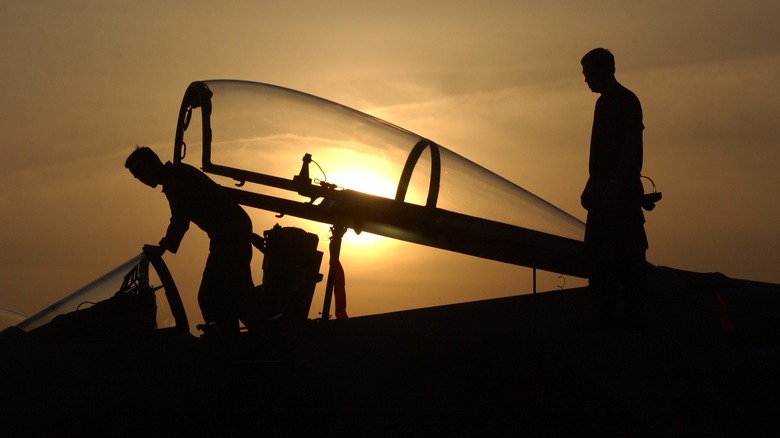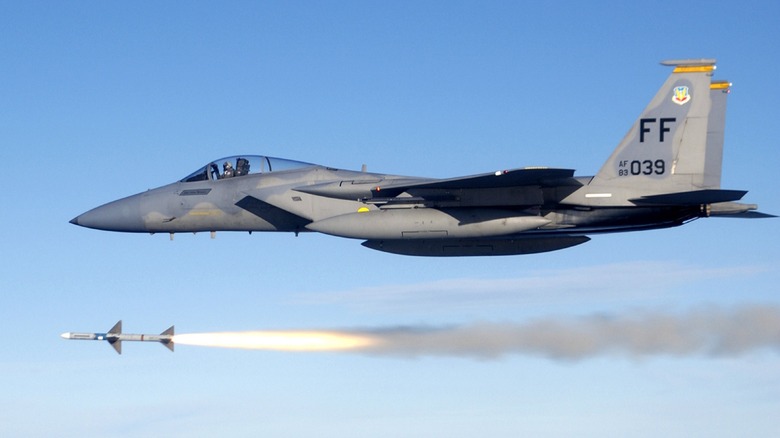The Key Reason Fighter Jet Canopies Aren't Bulletproof
If you've ever watched a movie like "Top Gun" or anything featuring modern fighter jets, you might ask yourself, 'Why don't they make those canopies bulletproof?" It's a good question, because it's not as if the technology doesn't exist. But that doesn't change the fact that fighter jet canopies, and the fighters themselves, aren't armored. There are several reasons why defense contractors don't armor their fighters' canopies, but first and foremost is weight.
It takes a great deal of energy to power something like the F-35 Lightning II's impressive turbofan engine, and it requires a ton of fuel. When it comes to armoring aircraft, there are tradeoffs — do you want your fighter pilot protected as much as possible while forgoing the ability to reach the desired speeds, or would you rather have the most agile fighter jets in the world that can pull off aerial maneuvers to keep pilots as safe as possible? The folks who buy fighter jets have leaned heavily into the latter, so you won't find a bulletproof canopy on an F-15 Eagle, a MiG-35, or a Chengdu J-20.
Bulletproofing also would reduce visibility, which is the last thing you want in a fighter jet's canopy. They're designed with composite materials to be strong, heat-resistant, and, above all else, fully transparent. When bulletproof glass is hit, it becomes opaque in a large area where the bullet made contact, significantly reducing visibility and the ability for the pilot to safely fly the plane.
There's no high-speed, low-drag on an armored aircraft
Modern fighter jets aren't light by any measure. An F-22 Raptor weighs 83,500 pounds when fully loaded, and adding armored plating, or even a bulletproof cockpit, would significantly increase its total weight. That would slow it down, requiring additional energy to reach the desired speed, so it would burn fuel faster than desired.
While they aren't bulletproof, fighter canopies aren't made of the same stuff as car windshields, and there's a ton of technology packed into what looks like mere glass. The F-22's canopy is gold, which aids in stealth, while some canopies are layered with explosives to facilitate rapid ejection in less than 0.4 seconds. They're also designed to be shatterproof, so if an unfortunate bird should fly into a fighter jet's path, the canopy won't break. And canopies must endure extreme temperatures. While it seems like they would have to deal with cold more than heat, that's not the case. Even at very high altitudes, heat is a factor because of air friction, and canopies are designed to handle this.
Fighter canopies are made from multiple layers of high-pressure acrylic or polycarbonate bonded together with silicone or other materials to protect the pilot from laser beams, ultraviolet light, and dispersing static electricity while providing zero optical distortion. Bulletproof material would compromise their heat resistance, their ability to be destroyed during an ejection, and their visibility.
Bulletproofing isn't needed in modern aerial combat
One of the biggest reasons fighter jet canopies aren't bulletproof is that it's not necessary. While it would have made sense during World War II, when fighter jets emerged, things have changed. Modern jets are still outfitted with cannons, but they're rarely used. Today's fighters often engage with enemy aircraft beyond line of sight using a variety of missiles capable of striking targets miles away.
Guns simply aren't useful in these scenarios, and fighter jets carry only a small amount of ammunition. For example, the F-35A only carries 182 rounds for its cannon — just three trigger pulls — and it's hardly unique. The threat of getting struck by a missile fired from the air or ground is far more concerning than a bullet striking the canopy.
Still, one modern U.S. warplane does feature some armor: the legendary A-10 Warthog. Because it's used for close air support and engages targets while flying low to the ground, some armor had to be installed. The cockpit has earned the nickname the "titanium bathtub" because it features a titanium shell meant to protect the pilot. Russia's Su-34 Fullback is reportedly armored to some extent, too, but these two aircraft are exceptions to the rule. All other fighter jets that operate — and the A-10 isn't a fighter jet — do not have armor or bulletproof canopies, and that's unlikely to change so long as the world's air forces continue shooting missiles at one another's aircraft.


